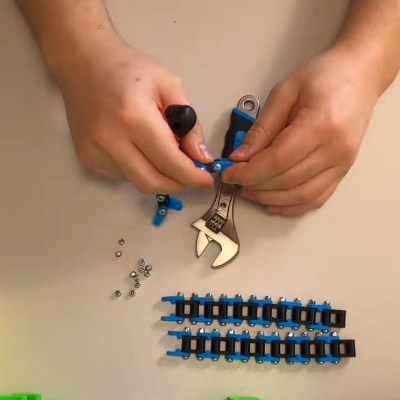One of the more frustrating things facing makers in decades past was the problem of power transmission. Finding things like belts, pulleys, sprockets, and chain for your projects could be difficult, particularly if you lived far from the shipping radius of suppliers like McMaster-Carr. These days, there’s no need to fuss, because you can simply 3D print whatever you need, as [Let’s Print] demonstrates by whipping up some chains.
 The chains are a mixed design, combining plastic inner and outer links with bolts and nuts to fasten them together. [Let’s Print] tries out several combinations of ABS, PLA, and PETG, running them on 3D printed sprockets and determining that they are all functional, albeit at minimum load. The chains are also put through tensile testing by attaching a heavy brake disc to a length of chain and dropping the weight to see at which point the chains snap.
The chains are a mixed design, combining plastic inner and outer links with bolts and nuts to fasten them together. [Let’s Print] tries out several combinations of ABS, PLA, and PETG, running them on 3D printed sprockets and determining that they are all functional, albeit at minimum load. The chains are also put through tensile testing by attaching a heavy brake disc to a length of chain and dropping the weight to see at which point the chains snap.
We’d love to see more 3D-printed chains; all-plastic snap-together designs, or even those that print pre-assembled are particularly tantalizing ideas. We’d also enjoy more testing done with the chain under some proper torque loads, rather than just spinning freely.
We’ve seen work from [Let’s Print] before, too – in the case of this awesome water pump. Video after the break.
















Pretty nice work, on the topic of McMaster Carr, to me having access to it alone constitutes a good reason to move to the US…
When I worked near Chicago, we would order parts from McMaster and they would sometimes deliver in a couple of hours. We could hardly believe it. Many years later, Amazon started doing the same thing, but not as often. Everyone in my field (machine building) loves the convenience and service provided by McMaster-Carr. This company is a testament to good leadership and excellent employees.
“A chain is only as strong as its weakest link”
Duration test seems to be done without any load, just the motor freely rotating, don’t know if it means much.
Plastic chain is probably good for drag cable chain though.
I think this vid has been shared on HaD
[youtube https://www.youtube.com/watch?v=FZN0PBBzEHw%5D
Bit of a stunt to collect clicks though, no?
I mean, bicycle chain is basically ubiquitous. And maybe even cheaper than all those screws and nuts this needs.
Use 3D printing for things it’s good for, not imitation & toy applications like this. The openflexure stage featured here several times is an excellent example.
The screws and nuts could probably be replaced by nylon rod of an appropriate diameter, cut to length. Just slip the cut-down bit of rod into the link, then press the ends with a hot iron to squash them and hold the rod in place.
It would be a lot simpler to just use pieces of the filament itself as pins.
But it’s still a less than stellar idea, when actual real chains are so available and cheap, and guaranteed to perform better than this wannabe-chain.
What’s the point of the drop tests ? Shouldn’t slowly increasing weight to see when it gives be a better idea than to just let a large weight just drop and see if it holds ? When are chains used in such way that they need to withstand such shock ?
when he posted this back in february I replied he should be checking for the amount of chain stretch instead.
This looks like a lot of hassle to assemble for unknown durability. Cool, but… Not that cool.
Power transmission can often be avoided entirely, or reduced down to where you can just use a belt or even a rope/rubber band/old shoelace.
It’s a big source of wasted power, and unreliability. I wouldn’t want anything this custom if I could help it.
Replacing the main X and Y-axis belts for chains on say the Tronxy printer but using small pitch teeth would make for some extremely precise and consistent printing. But I think a screw would be lest complicated. But that was my first idea before the screw…I do believe it will work but design is critical.
Needs shoulder bolts!
I would probably use brass tube instead of screws and then flare out the tube ends to retain them in a countersink shape. This gives a smooth surface to slide against instead of the screw threads and lowers the width of the chain.
Ordinary chain is pretty cheap, but this might be useful if one wants to make attachments, such as treads or scoops, which are more difficult with metal roller chain or toothed belt drives.
Ah – at the very end of the video he shows a tread.
I’ve been using this chain for months. It requires no assembly other than the end to end, and can be cut to size.
I haven’t tested it to breaking yet, but it works great for moving things. I’m not claiming it will drive a car, but even in a situation where it won’t ultimately carry the expected load, prototyping is a wonderful thing to be able to do before ordering parts.
https://www.thingiverse.com/thing:3480133
i keep hoping one of these projects will clue me into a better hack for the pins than using nuts and bolts. it seems like there ought to be something akin to a rivet for this purpose that i just haven’t thought of or seen on the shelf at the hardware store yet.